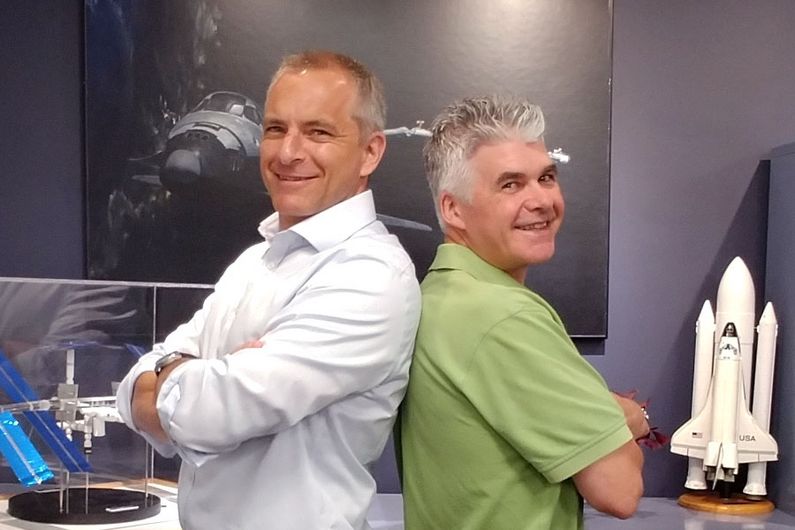René Pelletier, the osteopath who helped astronaut David Saint-Jacques readjust to life on Earth
- Forum
10/15/2019
- Martin LaSalle
In the weeks following his return to Earth, David Saint-Jacques was treated by several health professionals, including osteopath René Pelletier, a University de Montréal graduate.
On June 24, Canadian Space Agency astronaut David Saint-Jacques returned to Earth after spending more than six months in orbit on the International Space Station. In his first press interview a few days later, he confided that he was in rough shape when he left the Soyuz spacecraft.
While adjusting to gravity didn’t take too long, it took a while for Mr. Saint-Jacques to fully recover and the process involved input from several health professionals.
One of them is osteopath René Pelletier, who holds a master's degree in biomedical science and a PhD in rehabilitation science from the Université de Montréal.
We spoke to Mr. Pelletier about this out-of-this-world experience.
Did you ever think your career would involve treating astronauts?
Not for a second! But then I saw that the Canadian Space Agency was looking for an osteopath who specialized in sports medicine.
That was in October 2018, just a few days after I defended my thesis. A month later, they offered me a contract.
One of my strongest assets, in addition to my PhD in Rehabilitation Science from the Université de Montréal, is that I have nearly 30 years of clinical experience. After graduating from Concordia University with a bachelor’s degree in Physical Activity, I worked with high-performance athletes, including soccer players from the Montreal Supra, the Montreal Impact and the Canadian Women’s National Team. I also taught a course in sports medicine at Concordia University.
In 1992, I earned a master's degree from UdeM and got a job working for a sports medicine clinic. At the same time, I enrolled in a program at the Collège d'études ostéopathiques de Montréal and graduated in 1998. This combination of education and experience is what caught the Agency’s interest.
How do you prepare for helping an astronaut adjust to life on Earth after spending time in space?
Fortunately I had already started reading some of the scientific literature about the physiological effects of spending extended periods of time in a microgravity environment while I was doing my PhD at UdM. David Saint-Jacques left on December 3, 2018 and a few weeks later the crew from the International Space Station, including German astronaut Alexander Gerst, returned to Earth. I was sent to the European Space Agency in Cologne, where I met the people overseeing his rehabilitation plan. Since I was there when Mr. Gerst arrived in Cologne, I was able to observe his condition and how he was treated. In Germany, the astronaut rehabilitation team includes both an osteopath/physiotherapist and a kinesiologist, and the Canadian Space Agency used the same approach for David Saint-Jacques.
Last February, I travelled to Houston to familiarize myself with NASA’s facilities and meet the rehabilitation team that works with American astronauts. For privacy reasons, I can’t share any specifics about the treatments provided to David Saint-Jacques, but I can say that he had a physical after landing in Kazakhstan and was brought to Houston after that. He began treatment at the Johnson Space Center within 48 hours of arrival. My role was to prescribe him exercises, especially to regain motor control and flexibility, and to treat him using manual techniques.
I treated Mr. Saint-Jacques daily during his first 10 days in Houston and then I saw him for another two weeks at the Canadian Space Agency’s facility in Saint-Hubert. We even had an appointment recently because my work with him isn’t quite over yet. Depending on how things go, I may go back to Houston this fall to see how he’s doing.
How does six months of near-weightlessness affect the physical health of astronauts?
When astronauts return to Earth, they often experience vestibular and motor control problems in certain muscles. While in orbit, they do 90 minutes of exercise per day in order to maintain cardiovascular fitness and muscle mass, though their bone mass typically declines 1% per month spent in space.
Posture problems are another issue. When floating around the space station, they tend to hunch, with shoulders raised and legs rotated slightly inward. They lose flexibility in their neck, torso and hip muscles. Once they’re back on Earth and their muscles have to contend with gravity, astronauts typically report muscle tension, stiffness and general discomfort.
Spending long periods of time in space can also put astronauts at higher risk of a herniated disc, to the tune of four times higher than the average population. And their risk of a cervical hernia is 20 times higher.
Interestingly, astronauts grow anywhere from five to seven centimetres while in space. The discs and cushions between their vertebrae get longer because they aren’t compressed by gravity. Astronauts return to their usual height within about a week of coming home, but their discs can remain weak for up to a year.
Most of the time, they’re able to recover motor control quite quickly by doing their prescribed exercises and training programs. And while it can take up to a year to restore bone mass, bone architecture never fully recovers. But astronauts seem to do well nonetheless!













